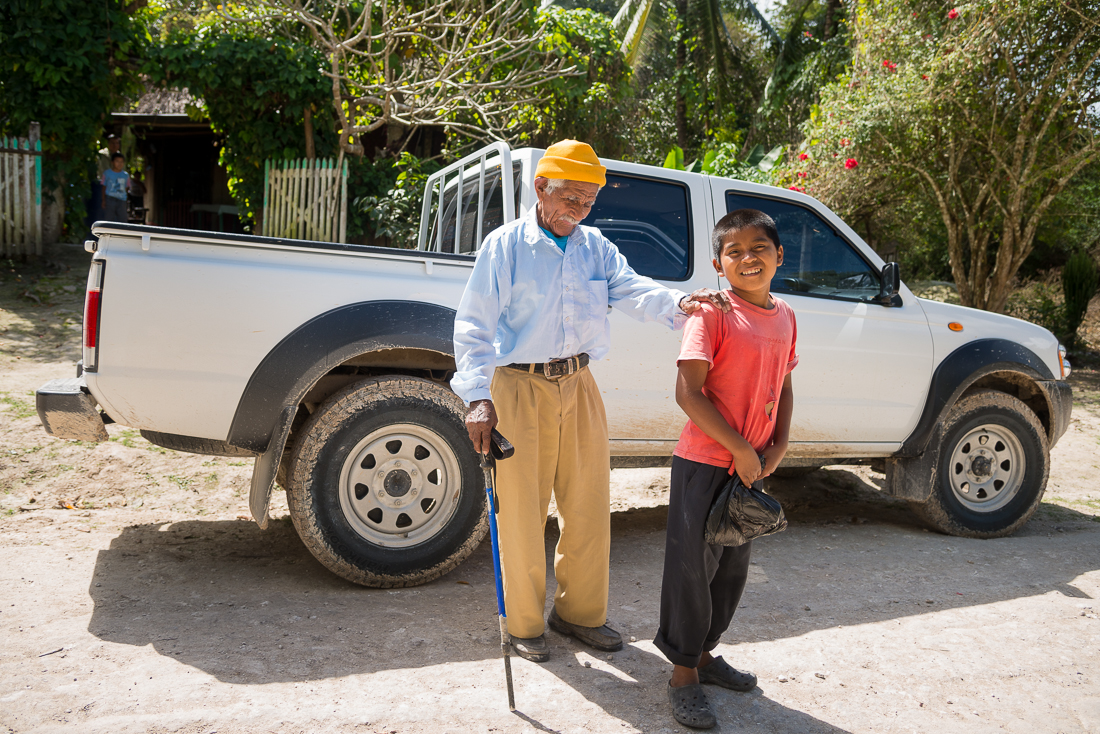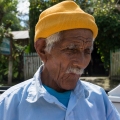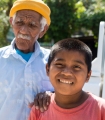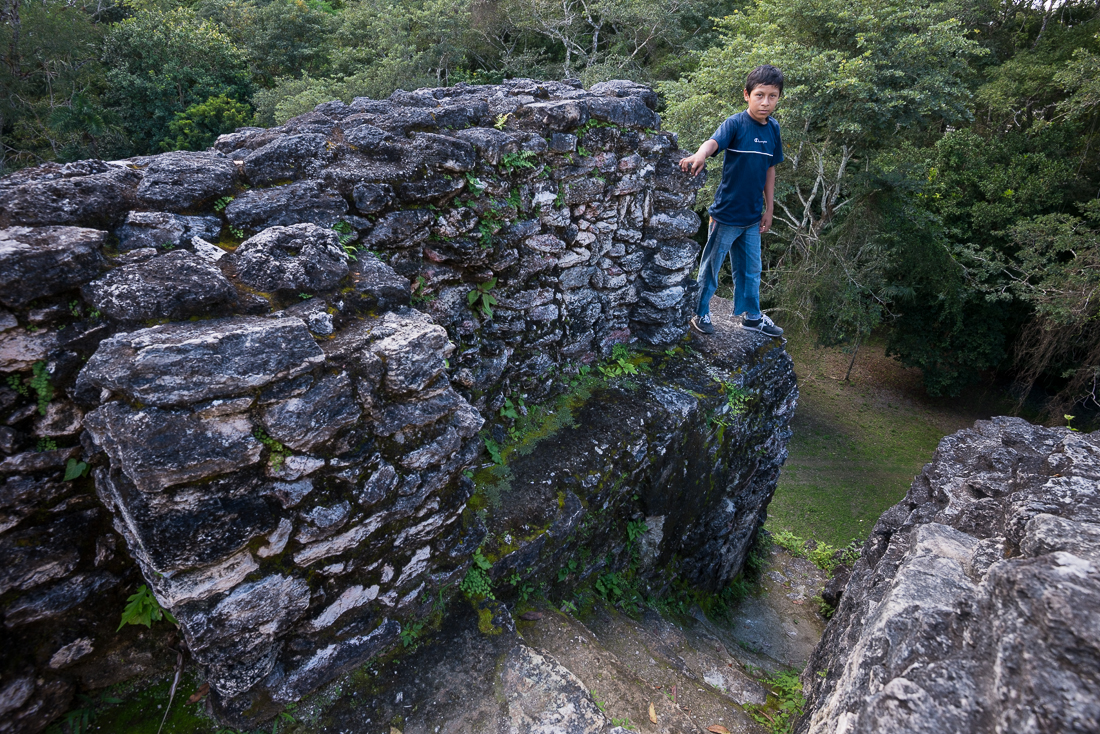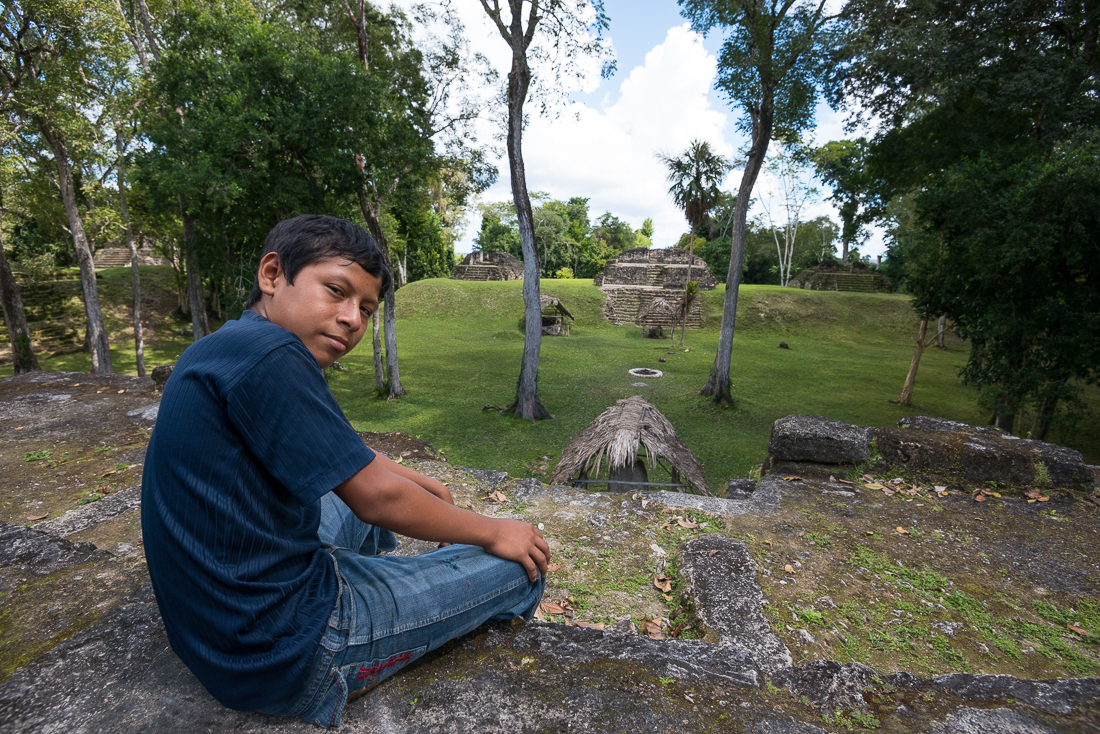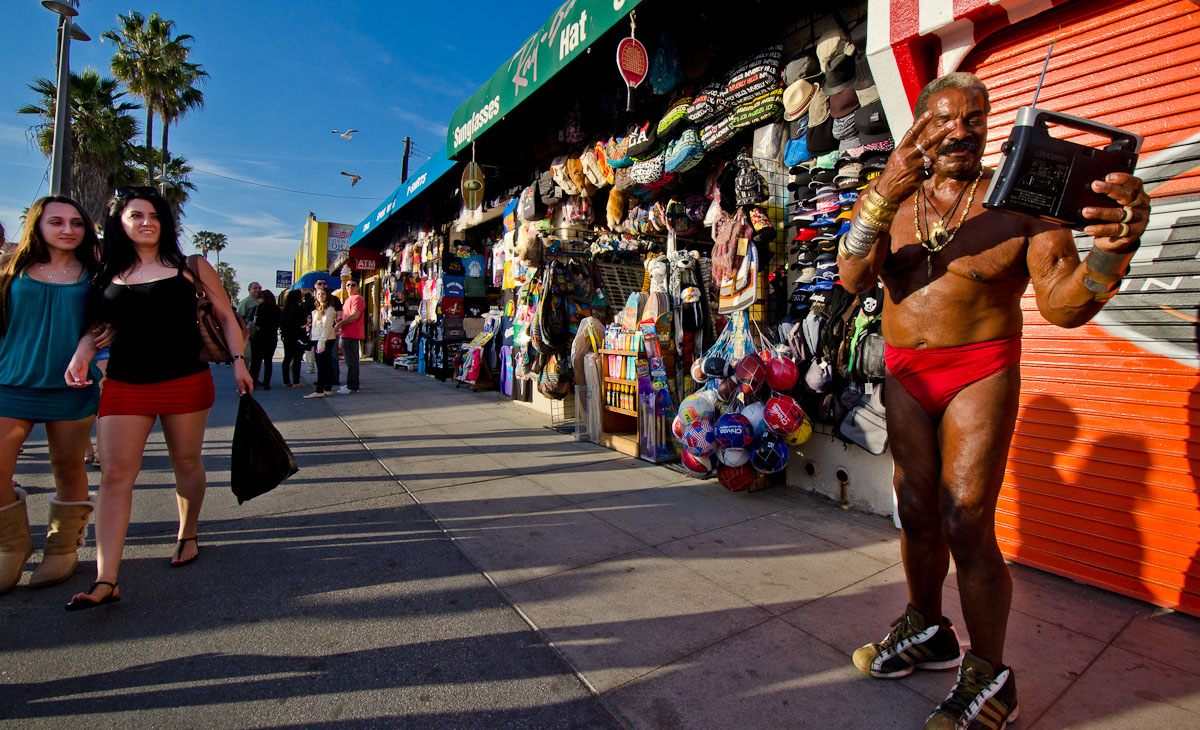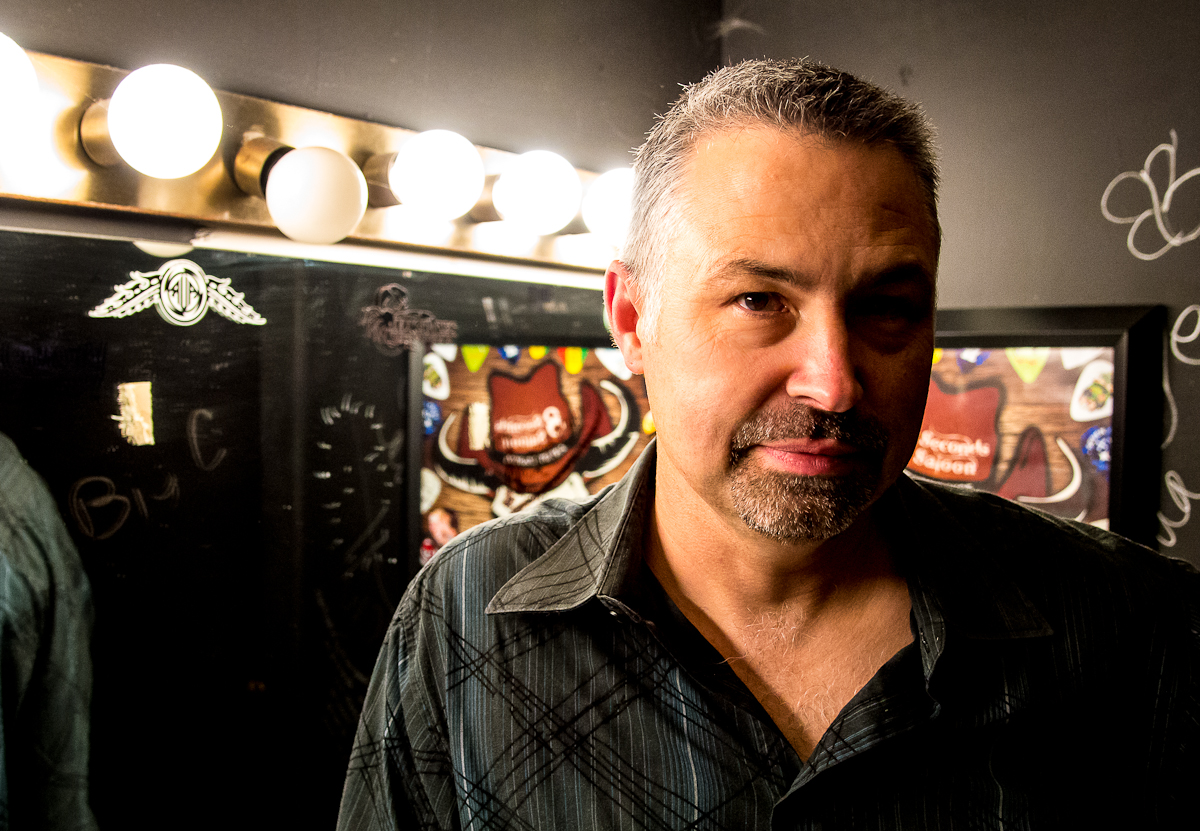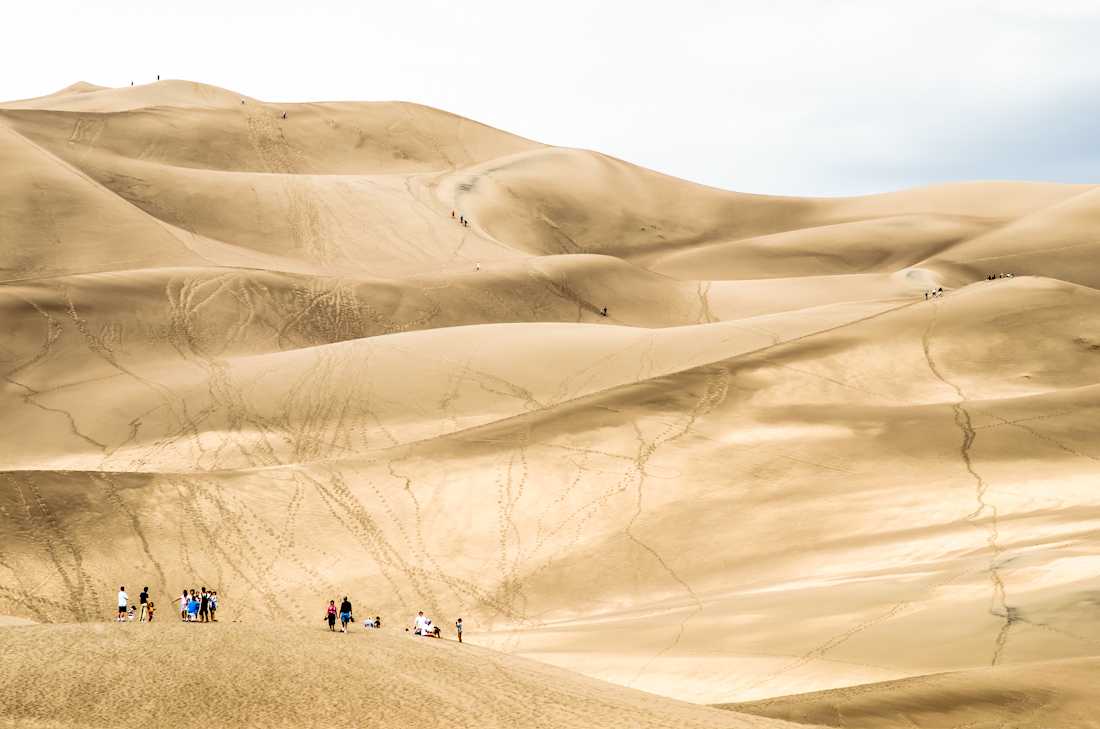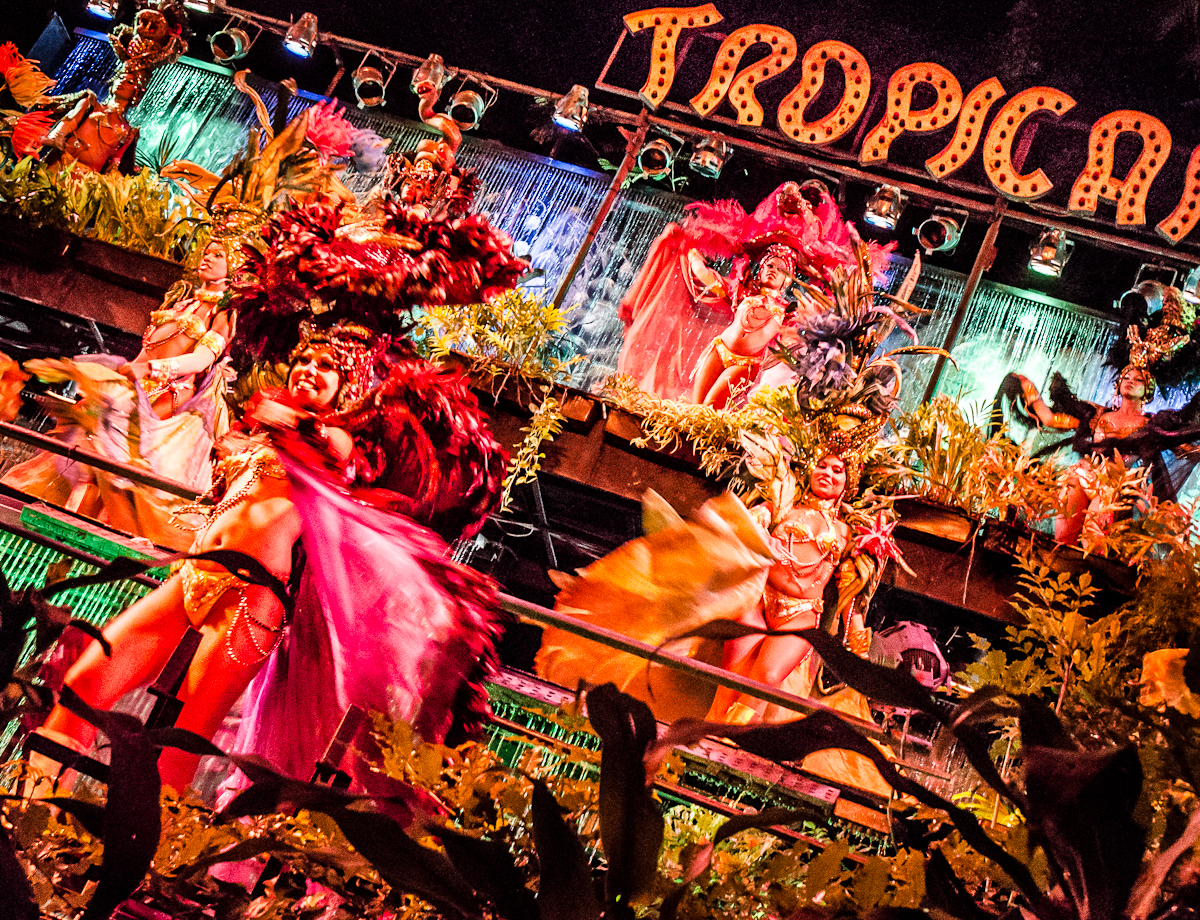The muddy, bumpy, 14-mile trek to the town (and the archaeological sites) of Uaxuctun takes just over an hour. So that’s how much time I got to spend with a blind, 100-year-old Guatemalan man named Julio and his great-grandson, Manuel. For this stint in Guatemala, I chose a 4-wheel drive Nissan pickup with tinted windows. I thought it might make it less obvious that I was a tourist and let me blend in with the locals a bit better. Perhaps it worked better than I thought.
The only way to get to see the Mayan ruins at the isolated Guatemalan town of Uaxactun (“Wash-ack-TOON”) is to start at Tikal and head north into the wilderness over a dirt road so muddy and bumpy it’ll take you over an hour to travel 14 miles.
As I pulled up to the gate at Tikal to start the trip, four men (a park ranger, a couple of security guards and another man) approached my car – all smiling ear to ear. One of them started to speak to me in Spanish, with another volunteering a sporadic translation. “He says, would it be okay . . . if . . . you . . . could give a ride to an old man? He can’t see. He’s . . . blind. He needs to get to Uaxactun.” Uh…Okay. I should point out (solely to convey the image – not because it’s particularly relevant) that, as was often true at a Guatemalan checkpoint of this sort, some of the people involved (not me) were toting shotguns and wearing a belt-full of shotgun shells (handguns were a rarity, even for policemen). I look over and see an ANCIENT blind man now tottering toward the car. I hear someone saying the phrase “tienes cien ANOS” (“he’s 100 years old”). I hop out, shake his hand, and try to introduce myself to the sweet old blind guy, only to realize that he’s also mostly deaf. Someone else tells me his name is Julio.
I gulp just a little at the responsibility I’m undertaking with a 100-year-old blind man in my car for a long drive through an unfamiliar muddy, rocky and isolated jungle road. Worse, as I get instructions for where to drop him off, the pivotal landmark seems to be the first “chicle” tree as I come into town. At this point, I see a ten-year-old kid starting to climb in the back of my truck. It’s apparently Julio’s grandson (“Manuel”). Somehow I’m relieved that Julio would have a caretaker (even a tiny one), though now I have two hitchhikers, neither of whom would be any help whatsoever if I got stuck along the road to Uaxactun. I assume, at least, that Manuel will recognize where to stop to drop him and Julio off. I insist that Manuel come around and ride INSIDE the truck with Julio and me.
They load up (sitting together in the back seat), and I pull forward about fifty feet to the gate, where I am met by another guard, who asks if I have the permit to take the car (truck) through the National Park. Crap. I’ve got a carload of Guatemalan dependents, and now I have to drive back to the “Administration” office and get a permit. As an aside: One would think that said office might be near the ROAD, right? It is not. I drive a ways, park (leaving the boys in the truck with the windows down), and walk the hundred yards or so up the hill to get my permit. Of course the man who writes out my permit (slowly) has a shotgun across his lap, but he’s otherwise friendly enough. Soon I’m headed back to the car, permit in hand. Julio and Manuel are as patient as can be.
It probably goes without saying that little Manuel does not speak a word of English. As we travel, I slowly formulate questions (carefully selecting from the short list of Spanish words I actually know). Manuel usually understands me okay, then rips out a rapid-fire (elaborate) response, of which I can usually understand maybe 20%. I learn names (Manuel and Julio), ages (10 and 100, according to Manuel). I triple-check the report on Julio’s ago (“?Cien anos?!!”). I learn that they both live together with their family in Uaxactun, and that Julio is some sort of abuelo (grandfather) to Manuel. I think maybe he was saying it’s his great- or great-great- grandfather (which might make sense, if it’s really 90-year age gap). I can’t figure out Manuel’s response about the reason they were in Tikal to start with. Manuel teaches me the word(s) for “bumpy” roads – (“lleno de baches” – full of holes), which was a very relevant and useful phrase at the time.
There is absolutely nothing along the road to Uaxactun: no intersections; no forks; no houses; no businesses. Nothing – except two signs reassuring me I’m still on the road to Uaxactun. And the jungle. We meet one other truck. I later learn that Uaxactun is notable – even among Guatemalans of the area – as a poor community. No electricity or running water (I see various systems for collecting rainwater though.) No phones. Apparently the residents are rather famous for their knowledge of the trees and bushes and berries and fruits of the jungle, for both nutritional and medicinal uses.
After about an hour, we see the first house at the edge of town. Manuel gets animated, and when I hear “aqui” (“Here!) a couple of times, I stop the car. We rush around to help his grandpa, and of course I also grab my camera. Julio pauses for a moment, but I don’t think he understood I wanted to take pictures (photography probably isn’t a very important concept to a blind man?). So they don’t stand still for long. I shook each of their hands and stammered out a Spanish “Goodbye – nice to meet you.” I wanted to follow them, but giving a hitchhiker a ride doesn’t automatically earn you an entry into their home, and neither of them was really even capable of inviting me. I yelled out one more Adios as they headed down the path.
======
The archaeologic sites at Uaxactun don’t really compare to Tikal – or even to Yaxha. But it was interesting enough and, much as at Yaxha, I pretty much had the place to myself, with two exceptions. The first was a dreadlocked white guy who spoke perfect English and said he was from Hungary. He was sitting on the ground in front of one of the more remote temples. I’m pretty sure he’d been smoking something. When I spoke to him, somehow he started giving me tips about bargain basement airfares to and from Cancun.
The other person I ran across was a twelve-year-old boy who popped up from behind one of the first monuments I saw. He introduced himself as a tour guide, available for hire. He spoke no English, but was still eager to show me around. We negotiated a generous guide fee for him (Why not, right?), and then spent the next couple of hours with him leading me from site to site. That’s Manolo in the dark blue shirt. The kid was sharp. He showed me some of the plants and trees that are used for medicinal and other purposes, and coaxed a tarantula out of its hole for my, uh, amusement. More than anything, he knew how to climb around every nook and cranny on the site. His entertainment was more than worth the 100 Quetzal ($12US) I paid him.
It turned out that Manolo’s mom was working back in Tikal – selling souvenirs right at the entrance. (I’d seen her that morning!). He asked for a ride. I declined, telling him that I wasn’t able to take a small boy to a faraway town without his mom or dad’s permission (or at least that’s what I tried to communicate). Manolo had an answer – I took him back to his home, where there was an English-speaking uncle who readily agreed that Manolo did need to get to Tikal. In fact, the uncle wanted a ride, too. I was practically running a bus service!
All went smoothly on the drive back to Tikal. The English-speaking uncle actually worked part-time as a real tour guide in Tikal, so I had an hour to quiz a knowledgeable local about all sorts of history and customs. Admittedly, the ruins at Uaxactun were a little anti-climactic after I’d spent the prior days at Tikal and Yaxha, but my hitchhikers surely made it worth the trip. As the old cliche says, sometimes the journey is more important than the destination.
